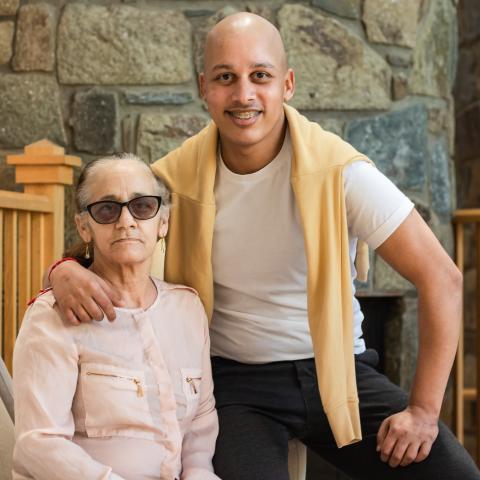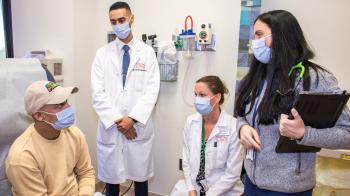
Luis Miguel Cruz has been sharing his cancer journey on social media since he was diagnosed with lymphoma in 2020. He touched the lives of countless others while finding the strength to keep going. “Every time I didn’t feel well, or I didn’t want to continue, thinking of [my] followers motivated me to continue fighting for my life,” he says. While Luis is at the NIH Clinical Center for a bone marrow transplant, he is required to have a full-time caregiver. For Luis, that is his mom, whose food, he says, “is magic.”
Luis Miguel Cruz is not camera-shy. Watch any of the 29-year-old’s social media videos, and you get a sense of his infectious energy. But many of his videos are related to the tough reality of his story: Luis, who is from the Dominican Republic, came to the NIH Clinical Center for treatment for a rare type of blood cancer.
“I was growing professionally and had great opportunities after I graduated from university with a degree in journalism,” he recalls. “But in the middle of the pandemic, in 2020, I started having symptoms and my life changed.”
Luis started feeling ill in January, but his cancer diagnosis — lymphoma — didn’t come until September because of the stress the COVID-19 pandemic was putting on the healthcare system. Luis’s doctor then told him to stop all activities and start chemotherapy as soon as possible.
The day of his first treatment coincided with his university graduation ceremony in December 2020. “I went to my graduation, I presented my thesis, and the same day, I went straight to the hospital to receive my first chemo,” Luis says. “I was in automatic gear. Everything was happening but I didn’t really realize what was happening.”
Chemotherapy took a toll on Luis, and that was when he found refuge in social media. “I felt alone, abandoned, and I felt like I was the only one going through all this,” he says. “When I made my first video, I realized there were many other people going through the same thing.”
Others shared their stories with Luis and told him that he inspired them to keep going. “But they didn’t know that they were inspiring me,” he says. “Every time I didn’t feel well, or I didn’t want to continue, thinking of those followers motivated me to continue fighting for my life.”
Six months after Luis finished treatment, his cancer recurred. The doctors in the Dominican Republic said they could stabilize him, but he needed a bone marrow transplant.
He was ready to give up when a friend suggested he use social media to see if anyone could help him. Luis posted an emotional video that went viral, and, despite encountering scammers who tried to take everything from someone who had almost nothing, Luis was put in touch with NIH and was able to join a clinical trial.
“It wasn’t easy to come to a new country by myself, but I’m so grateful to NIH and the whole team here who did everything to make me feel at home,” Luis says. “In the darkest days, there was always someone who gave me a gift of nice words, a hug or some kind of motivation to keep fighting.”
Though he was alone at first, he would need a full-time caregiver after his transplant, so his mom joined him. “She was like recharging my batteries to keep fighting,” he says about her arrival. “Her food is magic.”
Originally treated by the Lymphoma Branch, Luis ended up in the care of Jennifer A. Kanakry, M.D., Senior Clinician in the Center for Immuno-Oncology. Dr. Kanakry helped determine that Luis’s diagnosis was HTLV-1-associated adult T-cell leukemia lymphoma, a rare type of blood cancer that can involve the skin, lymph nodes, bone marrow and blood. He went from needing a transplant as soon as possible to really needing a transplant as soon as possible, Dr. Kanakry says.
Luis was an ideal candidate for a clinical trial that was not yet open, written by Kamil Rechache, M.D., Assistant Research Physician in the Center for Immuno-Oncology, with Dr. Kanakry as the principal investigator. The trial was designed for a narrow patient population, with specific donor requirements, to test a new drug regimen to prevent graft-versus-host disease (GVHD). GVHD is a potential complication of transplant where transplanted immune cells (the graft) attack organs of the transplant recipient (the host). Immunosuppressants work relatively well to prevent this, but these drugs have side effects and do not prevent all GVHD.
While Dr. Kanakry and her team were working hard to open this trial quickly and confirm that a suitable donor would be available and willing to donate, Luis was getting ready for the transplant. A bone marrow transplant essentially puts a whole new immune system in the patient, so the immune system must first be cleared out with chemotherapy.
“The weeks before transplant is a very intense period of time,” Dr. Kanakry explains. “The patient is being sent around the clinical center to every department, getting every part of their body checked to make sure that everything is ready for transplant.” Then they get admitted to the hospital to receive chemotherapy.
Finally, to everyone’s relief, all the pieces fell into place, and Luis was able to receive his transplant in February 2023.
Though Luis initially did well post-transplant, his cancer broke through the new immune system. The team decided to do a second transplant, with a donor from the national “Be the Match” registry.
“Everyone that I've had to take through a second transplant feels very defeated to face it,” Dr. Kanakry says. “It resets the clock and starts everything over again. But Luis is such a resilient patient. He must be frustrated but he doesn’t complain about it. He’s invested in his health.”
Luis passed his 100th day post-transplant in early September, which is National Leukemia and Lymphoma Awareness Month. “The first 100 days after transplant is when a lot of the major complications can occur,” Dr. Kanakry says, explaining the significance of this day. Many transplant patients go home after 100 days, but patients like Luis, who come from a place that doesn’t have a nearby transplant center, will typically stay for longer, usually at least 6 months after the transplant to monitor for complications in a specialized, transplant center.
After that, Luis will go home to the Dominican Republic, where he plans to reboot his career in journalism. But he will return to NIH every year for a check-up with the team. “Incredible people work here,” he says. “I accepted a risk in joining this trial, and in doing so, they saved my life.”
“Luis is one of those people that has a light in them that makes other people hopeful and happy,” Dr. Kanakry says. “He spreads joy.”
